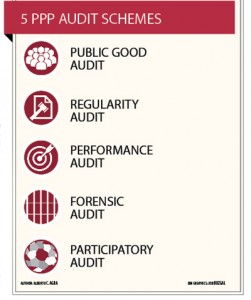‘Responsive-ility’ and responsibility Public-Private Partnership (PPP) arrangements—whether for water, reclamation, power, mass transport systems and…
Why audit of PPP contracts by COA the next hurdle
Why audit of PPP contracts by COA the next hurdle
 Why do some sectors say audit of public-private partnership (PPP) projects by the Com-mission on Audit (COA) is the next hurdle or challenge of awarded contracts? Why is a COA PPP Audit Guide (P3AG) a necessity? Do field auditors fully understand PPPs? What would be the harmful effects if field auditors have differing views on PPPs and varying interpretations of PPP contracts?
Why do some sectors say audit of public-private partnership (PPP) projects by the Com-mission on Audit (COA) is the next hurdle or challenge of awarded contracts? Why is a COA PPP Audit Guide (P3AG) a necessity? Do field auditors fully understand PPPs? What would be the harmful effects if field auditors have differing views on PPPs and varying interpretations of PPP contracts?
- Call for consistency. The absence of an official framework for audit of PPP projects and the comments by some that private funds may be subject to COA audit scare PPP stakeholders. Without a P3AG, COA Central officials and field auditors may make inconsistent and unsound audit findings.
- Urgent need. There is no doubt that the COA must issue a P3AG sooner rather than later. As the government awards more and more PPP projects, the COA must come out with the P3AG that would serve as guide to all. Uniformity, consistency, enforceability and acceptability of audit rules are all essential for a stable PPP policy.
- Participative process. The P3AG must be a product of broad consultations by all stakeholders—all levels of the COA, all levels of government, private sector, regulatory agencies and civil-society organizations (CSOs). Such process will facilitate ownership of the P3AG. The vibrancy and completeness of the PPP Learning Ecology also depend on the inclusion of audit on the learning agenda.
- Start with basics. The basics of PPPs is the heart or core of any audit guide. There must be a common appreciation of what a PPP is and what it is not; what are the value drivers of PPPs; what are the available PPP modalities; what are the approval processes; what are the roles and responsibilities of the parties, among others.
- Identify the principles. Preliminarily, the following seven principles are suggested: (1) Public good and better quality of life, not financial considerations alone, is the true measurement of PPPs; (2) Expansive, not restrictive, view of PPPs; (3) Innovation and liberality, rather than stringency and route thinking; (4) Exclusion, rather inclusion, of private funds in audit scope; (5) Performance-orientation, beyond fault-finding; (6) Remedial measure as against substitution of judgment and stymieing of discretion; and (7) Institutionalization of people’s audit through accredited CSOs.
- Defining types of PPP audit. Anchored on these principles, the COA should undertake or enhance the following five audit schemes: (1) Public Good Audit: to determine the impact and benefit to the people of PPP projects; (2) Regularity Audits: to ensure compliance with laws and approval processes (compliance audit) and to monitor revenues, recording and accounting of government income, expenditures, contributions, assets and liabilities, and internal controls (financial audit); (3) Performance Audits: to safeguard against unnecessary and imprudent expenditures and to check attainment of key performance indicators based on the contract; (4) Forensic Audits: to correct fraud and corruption in the implementation of the project; and (5) Participatory Audits: to engage the CSOs in making sure that purpose of the project is achieved.
A sound and stable PPP audit framework will augur well in future-proofing PPPs for the public good. We believe that the COA is up to the task.
